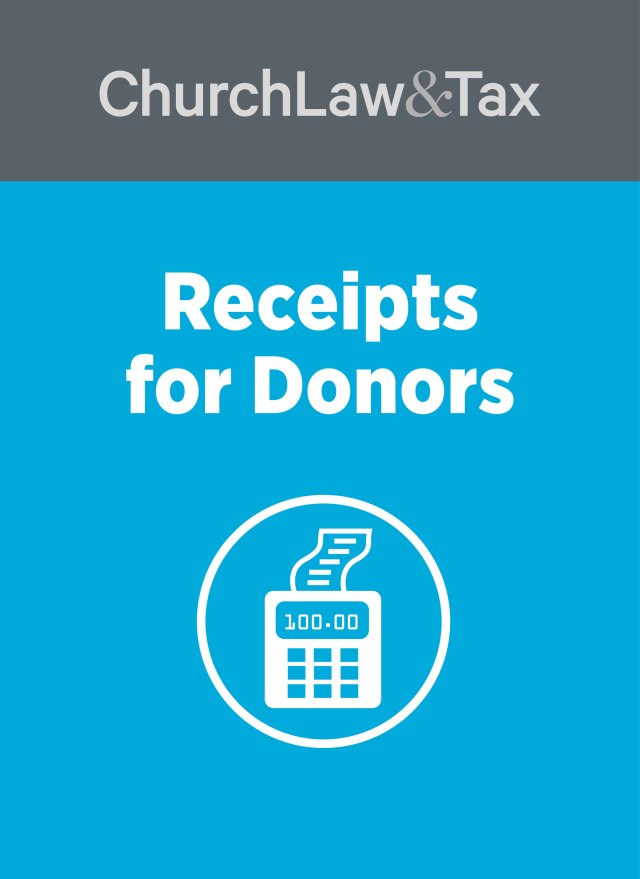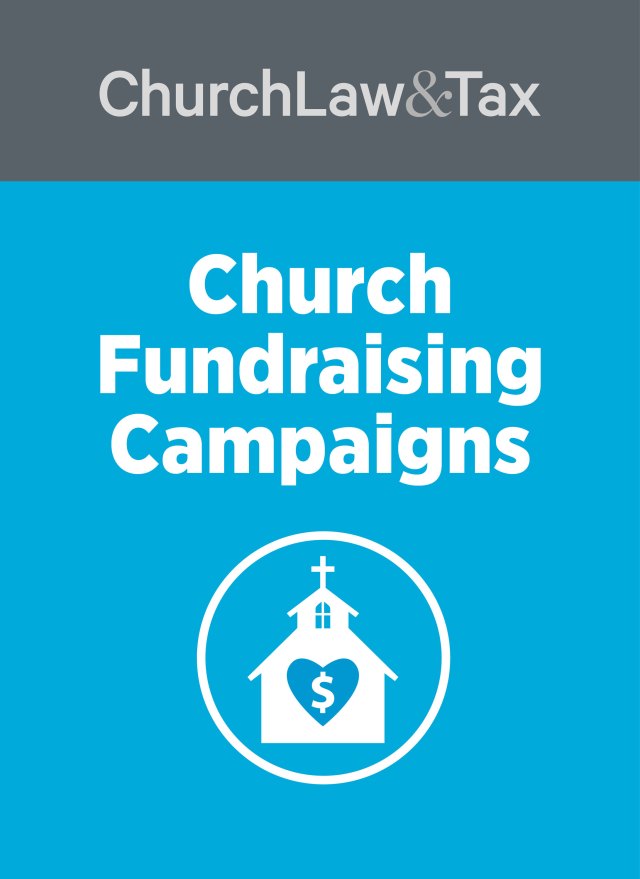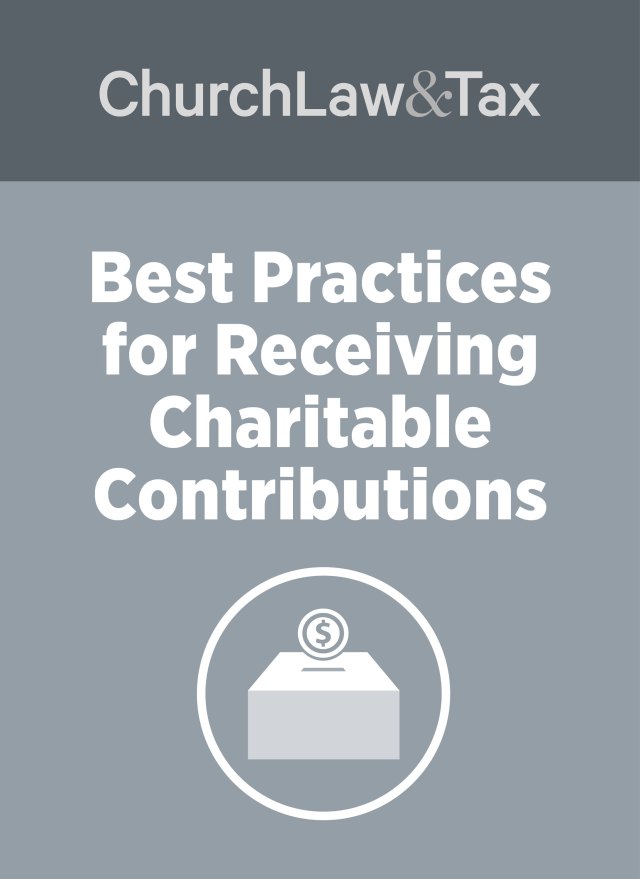Churches that receive a contribution of noncash property may be required to file a Form 8282 with the IRS. Not many church leaders are familiar with this form. This article will provide you with the information you need to comply with this reporting requirement.
Purpose of the form. The purpose of Form 8282 is to ensure that donors do not claim inflated values for property they donate to charity.
When is the form required? Your church is required to file Form 8282 with the IRS if you meet certain conditions. The following checklist will help you to quickly determine if your church needs to file this form.
Checklist #1
your church receives a gift of noncash property from the original donor
STEP #1. Did the donor present the church with a qualified appraisal summary (Form 8283, Part B) for signature? In general, any donor who claims a charitable contribution deduction of more than $5,000 for any gift of noncash property (other than publicly traded securities) to a church or charity must obtain a qualified appraisal of the donated property and then complete a qualified appraisal summary (IRS Form 8283, Part B). The appraisal summary is attached to the tax return on which the charitable contribution deduction is claimed. Churches receiving contributions of property valued by the donor at more than $5,000 must complete and sign Part IV of Section B of the donor’s Form 8283 appraisal summary.
• No. Stop here. No Form 8282 is required.
• Don’t know. You will need more information. Ask donors who gave noncash property to the church with a potential value of more than $5,000 whether or not they obtained a qualified appraisal and submitted a qualified appraisal summary (IRS Form 8283, Part B) to the church for signature.
• Yes. Go to step 2.
STEP #2. Did the church sell, exchange, consume, or otherwise dispose of the donated property within two years of the date of contribution?
• No. Stop here. No Form 8282 is required.
• Don’t know. Check the church’s records, and talk with the donor if necessary, to determine the date the property was contributed. Once the date of contribution is established, determine if the church sold, exchanged, consumed, or otherwise disposed of the property within two years of the date of contribution.
• Yes. Go to step 3.
STEP #3. Does an exception apply? A Form 8282 does not need to be filed if either or both of the following exceptions apply: (1) Form 8282 does not need to be filed if a church consumes the donated property or distributes it without charge to another organization or individual. The consumption or distribution must be in furtherance of the church’s tax exempt purposes. (2) If at the time the church signed the appraisal summary (see Step 1) the donor had signed a statement on the appraisal summary (Form 8283, Section B, Part II) that the appraised value of the donated property was not more than $500. This exception will apply if a donor contributes several similar items of property (having a combined value in excess of $5,000) to a church during a calendar year, and the church disposes of or consumes one item that is separately valued by the donor at $500 or less.
• No. Go to step 4.
• Don’t know. Review the instructions to Form 8283 (Section B, Part II), and also the instructions to Form 8282. Note that the instructions to Form 8283 are a separate IRS document, while the instructions to Form 8282 are contained on the back side of the form itself.
• Yes. Stop here. No Form 8282 is required.
STEP #4. You must file Form 8282 (only Parts I and III) within 125 days of the date you disposed of the property. There is an exception. If you did not file a Form 8282 because you had no reason to believe that the qualified appraisal requirement applied to a donor, but you later learned that it did apply, you must file Form 8282 within 60 days of learning of your obligation to file.
Key point. In the next issue of this newsletter we will address a related issue—what happens if a donor contributes property to a church, obtains a qualified appraisal and completes a qualified appraisal summary, but the church gives the property to another church or charity within two years of the date of the gift? Does the Form 8282 filing requirement “transfer” to the second church?
Key point. The Internal Revenue Manual (the IRS administrative manual) states that the tax return of any donor who contributes property valued at more than $5,000 to a charity should be selected for examination by the IRS if no Form 8282 is filed by the church. IRM 4175.2. Obviously, it is now more important than ever for churches to comply with this important filing obligation.
Miscellaneous rules. Here are a few additional considerations that will assist you in properly completing Form 8282.
- Missing information. The instructions to Form 8282 specify that you must complete at least “column a” of Part III. If you do not have enough information to complete the other columns, you may leave them blank. This may occur if you did not keep a copy of the donor’s appraisal summary (Form 8283, Section B).
- Where to file. Send the completed Form 8282 to the Internal Revenue Service Center, Cincinnati, Ohio 46944.
- Informing the donor. You must provide the donor with a copy of the Form 8282 you filed with the IRS.
Examples. The following examples illustrate the 4 steps summarized in the checklist.
Example. A member contributes a house to her church on July 1, 1998. The church sells the property on November 1, 1998. The church must complete and file Form 8282 with the IRS within 125 days of the date of sale, and also mail a copy to the donor.
Example. A member contributed a car to his church on October 1, 1997. The car had an apparent value in excess of $5,000, but the church is never asked to sign a qualified appraisal summary (Form 8283, Section B, Part IV). The church sells the car on July 1, 1998. It is not required to file Form 8282. See Step 1.
Example. A member contributed a car to her church on May 1, 1998. The car had an apparent value in excess of $5,000. The church sells the car on June 1, 1998, for $8,000. The church was never asked to sign a qualified appraisal summary (Form 8283, Section B, Part IV), and so it does not file a Form 8282. See Step 1. However, on November 1, 1998 the donor provides the church treasurer with a qualified appraisal summary for signature. Since November 1 is more than 125 days following the church’s disposition of the car, the filing deadline for Form 8282 was missed. However, an exception permits the church to file a Form 8282 within 60 days of learning that it is required to file the form. Since the church treasurer had no reason to believe that a Form 8282 was required until the donor presented the qualified appraisal summary on November 1, the church has 60 days from that date to file the form.
Example. A member contributes several shares of publicly traded stock to his church in July of 1998. The stock has a market value of $15,000. The church sells the stock within a few weeks. It is not required to file a Form 8282 because it will not be asked to sign a qualified appraisal summary (Form 8283, Section B, Part IV). The qualified appraisal summary requirement does not apply to gifts of publicly traded stock. Note that the qualified appraisal and Form 8282 requirements are designed to ensure that donors claim fair valuations for contributions of noncash property. In the case of publicly traded stock, the valuation is determined each business day by the stock market. There is no question as to proper valuation. As a result, the qualified appraisal summary and Form 8282 requirements do not apply.
Example. A member contributes a car to her church in June of 1998. In November, the member has a church board member sign a qualified appraisal summary on behalf of the church. The board member is not familiar with this requirement, and so does not inform the pastor, church treasurer, or any other member of the board. In January of 1999 the church sells the car. The church treasurer is familiar with the Form 8282 requirement, but does not file this form after the car is sold because he was never informed that the church had signed a qualified appraisal summary. This is a very real problem that can occur in any church. There are a number of ways to prevent this from happening. For example, the church could establish a written policy requiring a designated person (such as the senior pastor or church treasurer) to sign any qualified appraisal summary (Form 8283) on behalf of the church, and requiring a log or journal to be made of each qualified appraisal summary that is signed. If such a policy is clearly communicated to all staff and board members it is unlikely that the church will fail to comply with the Form 8282 reporting requirement.
Example. A member donates a car to his church in June of 1998. The church issues the member a receipt acknowledging the contribution. The church uses the car for three years before selling it. It is not required to file Form 8282 because it did not dispose of the car within 2 years of the date of gift. See Step 2.
Example. A member donates a car to his church in June of 1998. The next month the church board votes to give the car to the pastor. If the donor asks the church to sign a qualified appraisal summary then the church will be required to file a Form 8282 with the IRS. Part III, column e, would simply report “0” as the amount received upon disposition.
Example. A local business contributes food to a church for distribution to the needy. The church is not required to file a Form 8282 even if it is asked to sign a qualified appraisal summary by the donor. The Form 8282 requirement does not apply if a church distributes donated property without charge to another organization or individual in furtherance of the church’s tax exempt purposes.
Example. Same facts as the previous example, except that the church distributes the donated food to its members. The Form 8282 reporting requirement may apply. While the donated food is distributed without charge to church members, this may not further the church’s tax-exempt purposes unless the congregation is predominantly poor.
Conclusions. This article has reviewed what church treasurers need to know about Form 8282—when the church receives a gift of noncash property directly from the original donor. Different rules apply when a church receives donated property from another church or charity. Those rules will be addressed in next month’s newsletter.
In summary, be alert to any donation of property that may be valued by the donor at $5,000 or more. Be sure the donor is aware of the need to obtain a qualified appraisal and complete a qualified appraisal summary (Form 8283, Section B). It is a good practice to have some of these forms on hand to give to such donors. And, as noted above, designate one person to sign all qualified appraisal summaries on behalf of the church, inform the church board and staff of this policy, and make a record of each of these forms that is signed. This will help to ensure that the church is in full compliance with the Form 8282 reporting requirement.




